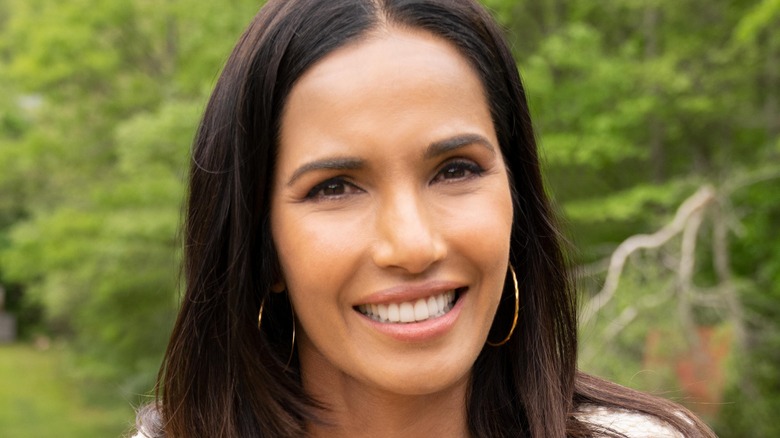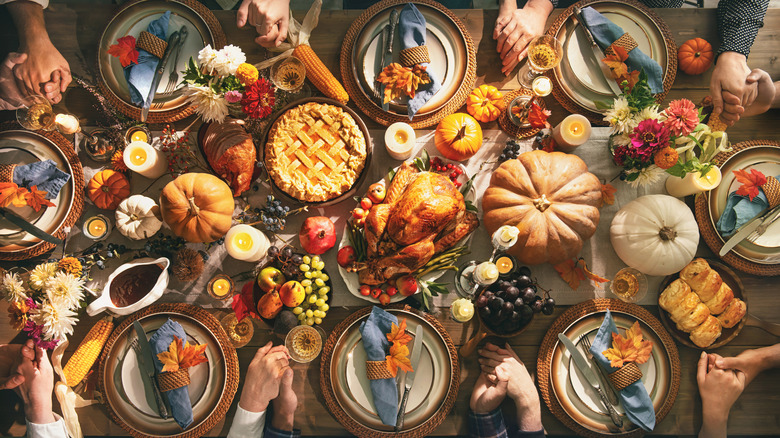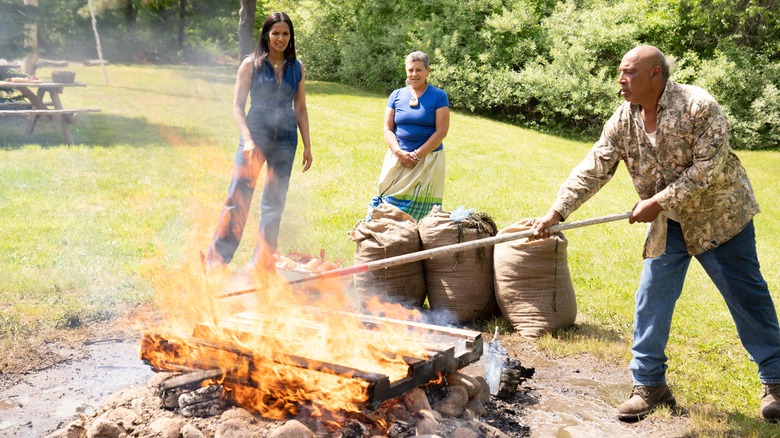Padma Lakshmi Shares How Today's Thanksgiving Tables Are Different From The Original - Exclusive
Every year as Thanksgiving rolls around, the same thing happens. Millions of turkeys get roasted, dishes of stuffing get baked, and countless potatoes are mashed. All of that and more gets spread across the dining room table for all of us to dig into, perhaps without even really thinking about why we're loading up our plates with this so-called traditional spread. Well, writer and food expert Padma Lakshmi has some answers. In the newest season of "Taste the Nation: Holiday Edition," she had the chance to explore the original roots of the holiday, straight from the source. "The real first Americans, one of the first nations of this land, are the Wampanoag people who traditionally, always lived in the Cape Cod, Massachusetts and Rhode Island area ... They've been around for 12,000 years and Western conquerors and settlers have only been here for five, 600 years," Lakshmi explained to Mashed.
While filming the show, Lakshmi met with their descendants and learned their side of the Thanksgiving story. "There's so many things that I learned that should be taught in every public school in this country, that I wish I had learned." Along the way, she also learned more about (and tasted) some of their traditional, seasonal foods — some of the exact foods you would have seen on the first Thanksgiving table. So how do today's turkey and stuffing spread compare? In an exclusive interview with Mashed, Lakshmi laid out which foods you would and would not see at some of the early Thanksgiving celebrations, in the place where the tradition got started.
Today's Thanksgiving dinners feature a lot of native, seasonal veggies
Whether you're a fan of them or try to feed them to the dog under the table, there's an array of colorful veggies that are served at Thanksgiving dinners around the country. And according to Padma Lakshmi, those plates of roasted squash, pots of corn or baked beans, and other vegetal items are pretty authentic to what was served at the original Thanksgiving feasts. She told Mashed, "a lot of the things like sweet potatoes, like corn, succotash ... beans, corn, squash, we would've eaten a lot of that."
At the end of the day, foods that are seasonal to the Northeast around November are likely what would have been on the menu at the first Thanksgiving. "Cranberries would've been there because they grew. Sumac, which we nowadays usually associate with Middle Eastern cuisine, would've been used to season things because sumac was something that grew wild also in North America," Lakshmi said. "What's available in the fall and end of summer" is what people had to eat because there was no other option at the time other than to eat what was in season.
And as Lakshmi noted, the Wampanoag people know a thing or two about what grows best. "They have been keeping this land and preserving all the wildlife and rivers and oceans and streams and shores for 11 and a half thousand years before anybody else got here," she said, adding, "they have a lot to teach us about the environment ... that we can learn from."
Turkey was not the main attraction at the original Thanksgiving
For so many of us, Thanksgiving wouldn't feel complete without a big, dressed-up, roasted turkey as the centerpiece of the dinner table. So it may come as a shock to learn that it's highly unlikely that the bird we know so well was the main feature of the original Thanksgiving. Instead, a look back on the story of the first Thanksgiving gives us a clue as to what the original Americans were eating instead.
"We probably would be eating venison because ... the original Thanksgiving meal is venison," Padma Lakshmi explained. She added, "The only thing that's true about that first Thanksgiving story that we've all been told year after year is that the indigenous people brought five deer with them to that big meal. They hunted and brought five whole deer because they were afraid they weren't going to have anything to eat because these settlers didn't know how to feed themselves and were starving." It's worth noting that there may have been a turkey somewhere on the table, though, as turkeys are native to North America, per the Old Farmer's Almanac. They just didn't become the star of the show until later on (via Britannica).
However, if you like to enjoy a ham on Thanksgiving, you're venturing into the inauthentic, according to Lakshmi. "We wouldn't have had pork or beef there," she said. And you can forget the stuffing. Lakshmi said, "We wouldn't have had stuffing made of bread because wheat is not indigenous to North American, indigenous culture, right. It was brought and cultivated later through colonialism."
You can catch Padma Lakshmi in the newest season of "Taste the Nation: Holiday Edition," now streaming on Hulu.


